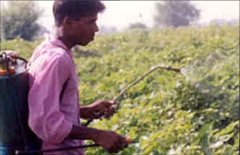Utter the word Punjab in India and one image that comes to mind is of green fields, turbaned farmers driving tractors, farm machines whirring and the chug of water pumps irrigating large fields. This was where the green revolution blossomed. This is the land Indian agricultural scientists boasted about for decades.
Unsafe pesticide levels in blood samples
The New Delhi-based Centre for Science and Environment (CSE) did a study of randomly selected blood samples from four Punjab villages -- Mahi Nangal, Jajjal and Balloh in Bhatinda district and Dher in Ropar district. The investigators in the study were Professor H. B. Mathur, Professor H. C. Agarwal, Dr.Sapna Johnson and Dr.Nirmali Saikia. The study found six to thirteen pesticides in virtually all the blood samples. Some of the pesticides were: HCH, Aldrin, DDT, Monocrotophos, Endosulfan, Phosphamidon, Chlorpyrifos and Malathion. Past studies in Punjab have shown pesticide residues in breast milk, milk from cattle, fruits and vegetables.
• Fighting for a better, cleaner world
CSE was receiving anecdotal reports cancer coming from particular pockets in Punjab for the last few years and it was well known that pesticide use was rampant. Earlier, the Post Graduate Institute, Chandigarh had asked the Pollution Control Board to undertake a study in Bhatinda to see the link between increasing cancer cases and pesticides. The study vaguely reported that pesticides might be responsible but did not disclose its findings on the blood samples. Second, Kheti Virasat, a Punjab based NGO trying to create awareness among farmers about the harmful uses of pesticide was also talking about how it suspected that pesticides were wreaking havoc with the health of the villagers. CSE researchers decided to find out things for themselves.
"Initial investigations revealed that the National Cancer Centre in nearby Bikaner of Rajasthan district where most of the cancer patients of Bhatinda were treated, had shown an increase of cancer cases by seven times in the last ten years", says Chandra Bhushan, Associate Director, CSE. Bhushan adds that CSE intentionally did not differentiate between those who had cancer and those who did not. There was a mix of cancer and non-cancer samples. "Having pesticide in the body may end up in cancer or may not. However, a significant number of cancer patients had high levels of pesticide in their blood", says Bhushan.
The CSE study is also one of the first in India to test for organophosphorous pesticides in human blood. Studies on animals have shown that even a single, low-level exposure to certain organophosphates, during particular times of early brain development, can cause permanent changes in brain chemistry. For example, Chlorpyrifos decreases the synthesis of DNA in the developing brain, leading to a drop in the number of brain cells. If these findings are extrapolated to humans, it may mean that early childhood exposure to Chlorpyrifos may lead to lasting effects on learning, attention and behaviour. Biomonitoring research has also shown that chemical cocktails in our bodies could be linked to numerous health problems like developmental disorders, fertility problems, neurological disorders and cancer.

![]() A pesticide sprayer in Punjab without any protection. Pic: Ramesh Menon.
A pesticide sprayer in Punjab without any protection. Pic: Ramesh Menon.
The study found organophosphorous pesticides in 75 per cent of the blood samples, while chlorpyrifos was present in 85 per cent samples. Seventy per cent of the samples also contained Phosphamidon and Malathion. The average levels of Monocrotophos in the blood samples (0.095 parts per million) were found to be four times higher than the short-term exposure limit for humans set by the World Health Organization and the Food and Agricultural Organization.
If we consider the long-term exposure limits, the results are more shocking: the average amount of Monocrotophos in the blood of those tested was 158 times higher than the long-term exposure limit for humans! The analysis has also shown that apart from older organophosphorous pesticides, new strains of pesticides had also come in.
Another New York study done in 2003 found that Chlorpyrifos and its toxic metabolite Chlorphyrifos oxon could cross the placenta barrier. The study found that if pregnant women are exposed to this pesticide even at very low levels, it could affect their unborn child.
Causes
With the green revolution came the use of chemical pesticides and fertilisers. Pesticides were used in high doses and it was often the dealer who would advise farmers on which pesticide to use. In the course of time, insects developed immunity to pesticides and excessive amounts of pesticide were pumped in contaminating both the atmosphere and the soil. Pesticides that do not easily degrade leeched into the soil poisoning it and also entered the water table. The air, the soil and water were poisoned. Pesticides like endosulfan that were banned in most parts of the world for their harmful effects, were liberally used. Likewise, with Monocrotopos, Lindane and DDT.
• Putting away the pesticide spray
• The slow poisoning of Punjab
Numerous villagers both in Punjab, Maharashtra and Andhra Pradesh said that they oversprayed with the hope that it would kill pests. But most of the pesticides were adulterated, helping the worm to easily develop immunity. Adulteration is not consigned just to Punjab; it is a problem all over the country. There have been numerous raids by government agencies in Warangal district of Andhra Pradesh for instance that have detected adulterated pesticides.
Cotton farmers would spray as many as twenty to thirty times in one crop cycle. There may be perhaps be no parallel to this anywhere in the world. Little surprise then that after India's Green Revolution started, pesticide use jumped hundred folds from 154 million tones in 1954 to 88,000 million tones in 200l. Punjab is one of the largest users of pesticides: 6,972 million tones a year.
Nearly 54% of the total pesticides used in India are on cotton crops alone. And cotton accounts only for five per cent of the total cultivated area. Bhatinda district in Punjab, which largely grows cotton, is known for excessive use of pesticides. Though the Punjab Agricultural University at Ludhiana recommends only seven sprays on cotton in six months, Bhatinda farmers have been known to spray as many as 32 times.
With higher costs from excess pesticide inputs, rich farmers soon ran into debt, as the cotton crop would fail year after year even though the farmers took loans to buy expensive pesticides. Many families, who were once rich due to the bounty in their fields, were caught in the spiral of poverty. Many committed suicide. Punjabis belong to a proud race; they were never known for suicides but many agricultural pockets started to increasingly witness them. Farmers killed themselves because they were too ashamed to swallow their pride and face the moneylender knocking on their door.
Umendra Dutt who heads Kheti Virasat says that one indication of the damage by pesticides is the increasing number of cancer cases in villages where there were high levels of pesticide use. He has been looking for a sponsor to aid research the link of pesticide use and disease, but has not been able to find any. Lack of research is often cited by the pesticide industry to insist that there is no scientific backing to fears that pesticide can cause cancer or harm human health.

![]() Water bodies in Punjab have also been polluted by pesticide run off. Pic: Ramesh Menon.
Water bodies in Punjab have also been polluted by pesticide run off. Pic: Ramesh Menon.
Sunita Narain, Director, CSE says that the fact that chemicals can suppress the immune system and in turn trigger disease is known. "But since no doctor will give you a death certificate that says the cause is an unknown trigger, the pesticide industry is safe. In this world of industry, the onus is on us to prove our death. But we must understand more so that the truth cannot remain denied", she adds.
Farmers now see the dangers of chemical farming. But there is rarely any help available either over the proper use of pesticides or with alternatives like the intricacies of organic farming. Rarely will you see a farmer wearing gloves or masks while spraying. Scientists and even government officials feel that pesticide companies must take on the corporate responsibility of educating the farmer on proper pesticide use. Pesticide companies do put usage instructions on their containers but most of the time it is so badly printed and in such small sizes that it is not legible.
In reality, extension workers of the government are supposed to educate farmers, but they are rarely available on the field and do not bother. In Warangal district, Andhra Pradesh, extension workers were often young boys who were straight out of information technology courses. Some were least interested in doing a field job of advising farmers. They were also intellectually unequipped to do so inspite of having gone through some training.
The future
Dutt has managed to get some farmers to move into organic farming in Bhatinda, but he knows he has a long way to go. Farmers are hesitant to opt for organic methods because in the initial years the yields are low and in Punjab, there is a clear aggressiveness to produce more and earn as much as one can. They are also not ready to give up cotton and opt for crops they used to produce a few decades ago.
How can we stop this chemical invasion? First, farmers must be trained in proper and scientific use of pesticides. They must be educated on precautions like wearing masks, avoiding alcohol on days when spraying is to be done, and not using pesticide containers other household use like storing cereals and so on. Second, organic farming needs wider support, just the way pesticides are subsidised and their use encouraged to raise crop productivity and resist pest attacks. (See: Transitioning to organic.)
The sooner the poisoning of India's fields is stopped, the better. There is little time to debate as the price that victims will pay will be very high.























